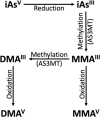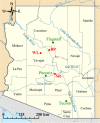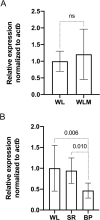Synonymous single nucleotide polymorphism in arsenic (+3) methyltransferase of the Western mosquitofish (Gambusia affinis) and its gene expression among field populations
- PMID: 33811567
- PMCID: PMC8060185
- DOI: 10.1007/s10646-021-02376-8
Synonymous single nucleotide polymorphism in arsenic (+3) methyltransferase of the Western mosquitofish (Gambusia affinis) and its gene expression among field populations
Abstract
Naturally occurring arsenic is toxic at extremely low concentrations, yet some species persist even in high arsenic environments. We wanted to test if these species show evidence of evolution associated with arsenic exposure. To do this, we compared allelic variation across 872 coding nucleotides of arsenic (+3) methyltransferase (as3mt) and whole fish as3mt gene expression from three field populations of Gambusia affinis, from water sources containing low (1.9 ppb), medium-low (3.3 ppb), and high (15.7 ppb) levels of arsenic. The high arsenic site exceeds the US EPA's Maximum Contamination Level for drinking water. Medium-low and high populations exhibited homozygosity, and no sequence variation across all animals sampled. Eleven of 24 fish examined (45.8%) in the low arsenic population harbored synonymous single nucleotide polymorphisms (SNPs) in exons 4 and/or 10. SNP presence in the low arsenic population was not associated with differences in as3mt transcript levels compared to fish from the medium-low site, where SNPs were noted; however, as3mt expression in fish from the high arsenic concentration site was significantly lower than the other two sites. Low sequence variation in fish populations from sites with medium-low and high arsenic concentrations suggests greater selective pressure on this allele, while higher variation in the low population suggests a relaxed selection. Our results suggest gene regulation associated with arsenic detoxification may play a more crucial role in influencing responses to arsenic than polymorphic gene sequence. Understanding microevolutionary processes to various contaminants require the evaluation of multiple populations across a wide range of pollution exposures.
Keywords: Arizona; Arsenic; Cyt19; Gambusia affinis; as3mt; mosquitofish.
Conflict of interest statement
The authors declare no competing interests.
Figures



Similar articles
-
Environmentally relevant arsenic exposure affects morphological and molecular endpoints associated with reproduction in the Western mosquitofish, Gambusia affinis.Sci Total Environ. 2022 Jul 15;830:154448. doi: 10.1016/j.scitotenv.2022.154448. Epub 2022 Mar 17. Sci Total Environ. 2022. PMID: 35307416
-
Human arsenic methyltransferase (AS3MT) pharmacogenetics: gene resequencing and functional genomics studies.J Biol Chem. 2006 Mar 17;281(11):7364-73. doi: 10.1074/jbc.M512227200. Epub 2006 Jan 6. J Biol Chem. 2006. PMID: 16407288
-
Polymorphisms in arsenic(+III oxidation state) methyltransferase (AS3MT) predict gene expression of AS3MT as well as arsenic metabolism.Environ Health Perspect. 2011 Feb;119(2):182-8. doi: 10.1289/ehp.1002471. Epub 2010 Sep 24. Environ Health Perspect. 2011. PMID: 21247820 Free PMC article. Clinical Trial.
-
Individual variations in inorganic arsenic metabolism associated with AS3MT genetic polymorphisms.Int J Mol Sci. 2011;12(4):2351-82. doi: 10.3390/ijms12042351. Epub 2011 Apr 4. Int J Mol Sci. 2011. PMID: 21731446 Free PMC article. Review.
-
Arsenic Methyltransferase and Methylation of Inorganic Arsenic.Biomolecules. 2020 Sep 22;10(9):1351. doi: 10.3390/biom10091351. Biomolecules. 2020. PMID: 32971865 Free PMC article. Review.
Cited by
-
Arsenic Impairs Wound Healing Processes in Dermal Fibroblasts and Mice.Int J Mol Sci. 2024 Feb 10;25(4):2161. doi: 10.3390/ijms25042161. Int J Mol Sci. 2024. PMID: 38396835 Free PMC article.
References
-
- Bortone SA, Davis WP. Fish intersexuality as indicator of environmental stress. Bioscience. 1994;44:165–172. doi: 10.2307/1312253. - DOI
MeSH terms
Substances
Grants and funding
LinkOut - more resources
Full Text Sources
Other Literature Sources
Medical
Research Materials

